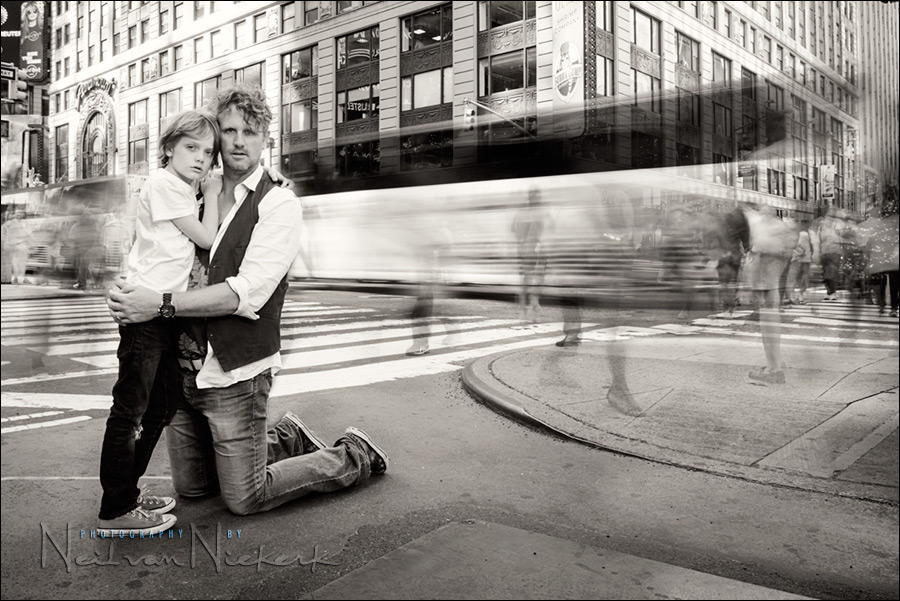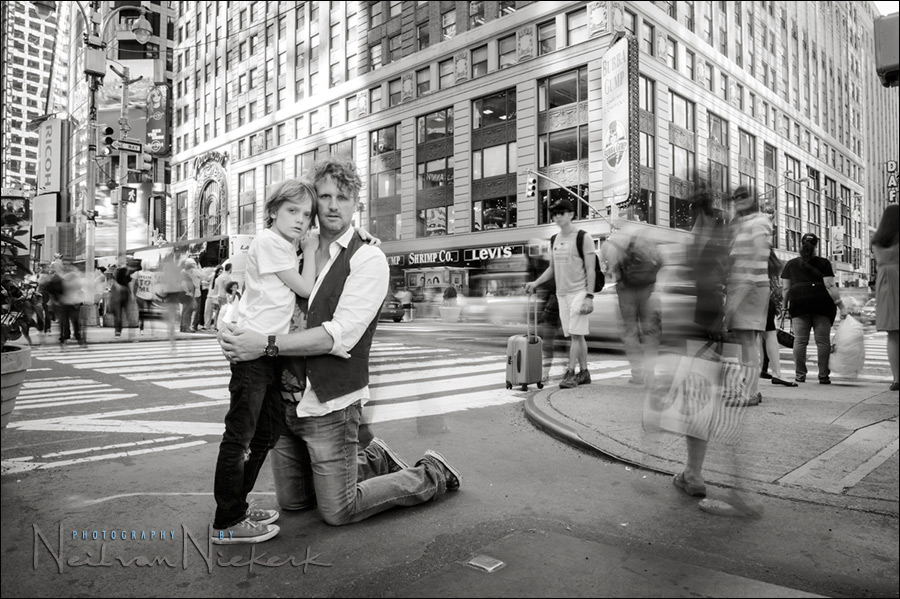
Father and son portrait – Deconstructing a photograph
My friend, Chuck Arlund, visited New York with his son Lachlan, for a few days. At the end of the trip, I had a short opportunity to photograph them. Since this is Chuck, whom I greatly admire, and his son (who is so used to a camera by now), I wanted to come up with something outside of the usual guaranteed way of working with a longer lens, and a simpler background. I wanted something a little out of the ordinary.
What I envisioned was some place in New York that was very busy, and then go to a slow shutter speed, and let everyone that is moving around them, turn into ghostly figures. The idea I had in mind, was with the two of them central in the image, and figures flowing around them on either side. I wanted that symmetry.
But as usually happens, real life limitations and opportunities kick in, and you end up with something slightly different than originally envisioned.
The merits of a photograph
Now, I have this half-formed philosophy in my mind, that the effort you went to to create a photograph, is largely not that important. Whether you were hanging by one hand from a bus that was careening over a cliff as you took the shot, is of little consequence. In other words, the trouble you went to to create a photo, is largely irrelevant.
Unless mentioning the person or place or event provides necessary context, a photograph created for artistic intent, should stand on its own. Impact should not have to be explained. Neither should excuses be made for lack of impact.
Yet, there are limitations that you need to deal with while taking a photograph, that the viewer should not have to know specifically. The photograph should have impact. Regardless.
How does all this relate to the photo at the top? I was unsure about its impact and asked for opinions on Facebook. Interesting. Aside from a few informing me how I could control my depth-of-field, the response was very good. A lot of questions and comments came up, and this might make for a good point of discussion here.
The idea and the set-up
As mentioned, the original idea I had in mind was a wide shot, with a sweeping view of a street scene, with movement all around them, while they are still. In that sense, they would be isolated amongst all the movement. I wanted to do this all in-camera, and still add flash on them to light them perfectly.
Times Square immediately came to mind as a place where there’d be a horde of people milling around, but which would offer wide enough place to shoot this. Yet the direction we could shoot in was limited by the pedestrian flow, barriers, as well as policemen that asked me to hurry up. So the pressure is on to make the idea work, here, and now.
- Camera settings
The image at the top was shot at: 1 sec @ f/22 @ 50 ISO
(This translates to a more usual equivalent: 1/125 @ f/2.8 @ 100 ISO)
Yup, the light levels there in-between the buildings on a cloudy day was quite low.
To add enough light on them at f/22, I also brought the powerful Profoto Acute B2 600 Ws powerpack (affiliate) and a Profoto beauty dish with a 22″ sock (affiliate). Now of course, my choice would be the Profoto B1 flash (500 Ws) (affiliate), which would be easier to set up and use.
Now it was a matter of balancing all this – flash and daylight (at a slow shutter speed).
So how to drop the shutter speed to sloooow levels on a bright day while retaining a wide-ish aperture? A Neutral Density filter. We’ll leave that for the homework bit at the end. (I ended up not using an ND filter here for shallower depth-of-field.)
- Angle of view
I had to shoot at an angle here to get a clear view of the street, without barricades in the way. It was also a busy intersection, so it was more likely people would be moving along. What happened though, was that people in the distance, would appear sharper, because their movements would be “smaller” from my camera’s perspective.
- Composite background to simplify
Some people would move too slow or would linger, and appear too sharp. In the end, the photo at the top was a composite of 5 photos, as I made the background more simple.

This complete frame of the image, shows that the people on the left (and people standing still), are too clear. So I cropped the image to remove the smaller figures on the left. I also combined 5 photos in total for the background. The bus streaking past hid the lettering on the buildings. Without the lettering there, pulling your eye away, the image is simplified.

Summary
In the breakdown of the behind-the-scenes decision, some of the mystery is perhaps inevitably lost. I guess that is why magicians don’t reveal the secrets. In the end, I hope that this photograph of a dad and his son would be evocative, and slightly mysterious … a tender emotional bond, an island in the craziness of the world. A permanence.
I hope it will draw the viewer in for a while, with this stillness juxtaposed with the motion.
Photo gear (or equivalents) used in this photo session
- Nikon D4
- Nikon 24-70mm f2.8G AF-S / Canon 24-70mm f/2.8L II
- Profoto Acute B2 600 Ws power pack
or alternately, the Profoto B1 flash (500 Ws) - Profoto beauty dish with the 22″ sock for a beauty dish
- Manfrotto 1004BAC – tall light-stand
Related articles
- Using a neutral density (ND) filter with flash (model – Anelisa)
- Using a ND filter to control DoF with flash (model – Ulorin Vex)
- What are your camera settings?
A little bit of homework
- What would the effect of a Neutral Density filter be here for the settings used? 1 sec @ f/22 @ 50 ISO
- If I had wanted to shoot in bright daylight – 1/250 @ f11 @ 100 ISO – (remember the Sunny 16 rule!) – and I added a 3-stop / 6-stop / 10-stop ND filter, what would my eventual (realistic) aperture be if I decided to use flash at a slower shutter speed?

Excellent vision and execution Niel! – I think the B&W also enhances the image a lot – well done!
Fantastic image, and a thought provoking article (and not just regarding the exposure math).
Was the setup for the photograph a distraction that caused any problem? You depend on the world around you to continue in motion, but with all the lighting gear, and Chuck on his knees embracing a kid, there must have been curious onlookers. How did you manage that situation?
I sometimes have problems with onlookers at beach and park locations during engagement sessions. Usually people know to keep behind me, but… for the rest, there’s photoshop. :-(
If you wouldn’t mind sharing, what actions did you use to blend the background and only get the objects with the blurred motions you desired?
How did you/they know the non-smiling expressions would work so well? Or did it just happen that way? It totally works here. Smiling wouldn’t work, not as well, would probably make it look more like a tourist shot. I think this is a big reason why the photo is so great.
Congrats on taking a risk, especially with another photographer. Fantastic photo.
Glad to see it became a tangents article Neil. I hope I wasn’t part of the few informing you how to control your depth of field! That was a good point in terms of the obscuring of the lettering on the buildings opposite, it is distracting and the bus blur definitely is effective. A longer exposure wouldn’t have helped on that front.
On the homework front, I cant make head nor tail of the second question, maybe because I am over-complicating it in my own head.
The first one I imagine is purely related to shutter speed, given the D4’s extended low ISO is 50 (I think) and the low aperture limit of the 24-70 is f/22, then you are out of options in terms of stopping down the ambient light with ISO and aperture, the only variable available is shutter speed, so without an ND filter you were maxed out at 1 second. Adding an ND filter will only allow you increase the exposure time. So add a 5 stop filter will allow you to go to 30 seconds, nothing else can change as your settings are at their limits. Add a 9 stop filter will allow you go to 30 seconds, open the aperture to below the diffraction limit of the camera/lens to f/8 and then allow you up the ISO to the native base ISO (non extended) of the D4 which is 100 meaning better dynamic range.
I’m still trying to figure out No 2.
When I saw that photo, I knew instantly that it was Chuck. I have taken a few classes of his here in KC and I love his work. Hes is always an inspiration to me. Great shot. Thanks for sharing.
Neil, this photo is incredible! It’s definitely not the typical family portrait. There’s so much to see here, yet father and son are clearly the dominant subjects. Excellent!
Hello Neil
I really love your work and your flash techniques-but if I want to be honest, I don’t like this one.
First of all, coming from photojournalism, I feel that a photo should be composed of one frame, not six. But this is just me, I am not calling you a cheat or anything (since you volunteered the explanation anyway).
Even as a composite, I don’t really like the result, the background feels distracting and unreal, with parts of people’s legs sticking out from a spaceship swoosh, and I don’t really see why it is black and white in such a colorful setting.
This is a technique that is not straightforward at all, it is not something that works everytime. You might have done everything properly, but you need a lot of luck in getting all the pedestrians and cars move at the right moment and in the right way. If it doesn’t work, you have to try again and again and again, in order to catch the right amount of blur-nothing you can do about it, you need a lot of luck and you cannot control it.
I have had better luck with somewhat faster shutter speeds, maybe from 0.3″ to 1/10. This evens out the motion blur (if you stay open for one second, there is a much much bigger difference between someone who is walking fast and someone standing, which does not happen when you choose a slightly faster shutter speed).
Please understand that I am not trying to be disrespectful but only to offer constructive criticism-this is obviously a subjective matter, so I am not “right” or “wrong”, I just have a different view on this.
Costas
P.S. did I say that I really love your work?
Very nice image and ‘behind the scene’ outline.
What this image says to me is that the time we have with our children is too short: life intrudes, time passes and moments like this need to be snatched. Comments about depth of field and “a photo should be composed of one frame” miss the point entirely. The question is: does the image work? For me, it does, in spades. Bravo!
Hi Neil- Love your work. I like both the first image ( out of the camera so to speak) and the composite. And if you wanted to crop it down to just a portrait of the father and son- that works too. You are a master.